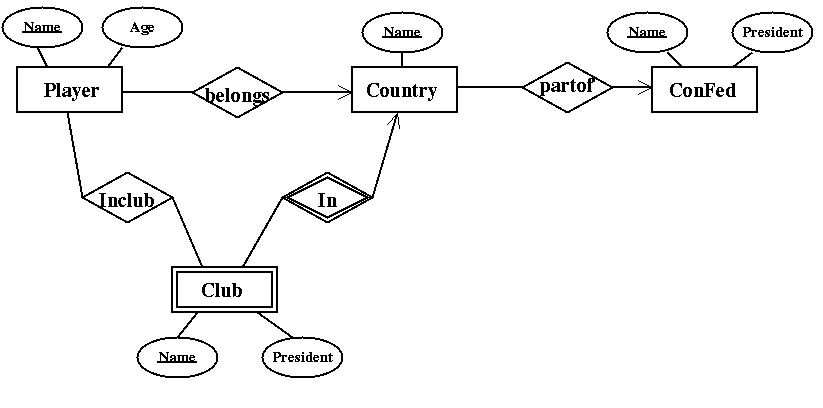CS145 Assignment #2
Due Wednesday, Oct 15, 1997
Reminder for on-campus students: Assignments are due at 5:00
PM on Wednesday. You are allowed one lateness of up to 48 hours;
use that privilege carefully. Assignments should be turned in during class
or at the course secretary's office: Gates Building room 495.
Reminder for SITN students: Assignments due on Wednesday must
be timestamped by the Thursday morning courier to be considered on-time.
Like the on-campus students, you have one free 48-hour exception.
Step 2 of Your PDA (Personal Database Application)
- (a)
- (15 pts.) Consider the ODL schema you designed for your PDA
in Assignment #1. Please attach a copy of the schema. Use the method described
in the text and in class for translating an ODL schema to relations to
produce a set of relations for your database design. Please specify your
relational schema using notation of Section 3.1.2, and underline key
attributes. In cases where there are alternative mappings for ODL constructs
(such as for sets and relationships), you may use whichever mapping you
prefer.
- (b)
- (15 pts.) Consider the Entity-Relationship diagram you designed
for your PDA in Assignment #1. Please attach a copy of the E/R diagram.
Use the method for translating an E/R diagram to relations described in
class and the text to produce a set of relations for your database design.
Again, specify your relational schema using the notation of Section 3.1.2,
and please be sure to underline key attributes.
- (c)
- (10 pts.) Which of the two relational schemas you obtained in
parts (a) and (b) of this problem do you like better? Is there anything
you still don't like about the schema (e.g., attribute names, relation
structure, duplicated information, etc.)? If so, modify the relational
schema to something you prefer. You will be working with this schema quite
a bit, so it's worth spending some time to make sure you're happy with
it.
- (d)
- Login to Oracle, using your Oracle account, which should be set up
shortly after Oct. 6.
Use the Oracle Introductory Guide to see
how to login and change your password.
Try some simple commands, such as help or table (relation) creation.
No credit will be given,
but it is important that people try logging in as soon as there is a good
chance your login will be recognized. We'll need time to handle login problems
such as someone who thinks they are registered for the class and isn't.
Don't forget to save a copy of your PDA for reference as you
do Step 3 of the PDA.
Problem Set
- (6 pts.) This question
is based on Exercise 2.5.3 in the text [p. 71].
In particular, the notion of ``smallest key'' is defined there.
Consider a three way relation R
E1 <----- R ----- E2
|
|
|
|
E3
where Key for Ei is Ki. Give the smallest posiible key for R
- (6 pts.) Suppose there are three entity sets E, E1
and E2, and there are many-one relationships from E1 to E
and from E to E2. Prove that there exists a many-one relationship
from E1 to E2.
Recall that a many-one relationship means there is ``at most one,''
not that there is ``exactly one.''
- (8 pts.) We would like to design a database to maintain some
information about books stocked in various libraries.
The information includes:
- Books: with their title and author
- Libraries: with their address
- Stocks: including the catalog number (which is unique to a particular
library), the name of the book , and the library where they are stored
- (a)
- Give the E/R diagram for this design. Identify the keys and the
weak sets and relationships
- (b)
- Now we need to add the entity set
Issue_records to our database which include
the name of the person to whom the book is issued, issue_date, due_date
and the return_date (this attribute
might be empty for books not returned as yet). Modify the E/R diagram to incorporate
these changes.
- (16 pts.) Our next task is to design a database for students
and courses (again). The information includes
- Students with their name and student id, department, their advisor,
and the courses in which enrolled
- Courses with the name, department, instructor and the TAs
- Faculty with the name and department and
- Department with the name and the building where it is located.
a) Implement the above in the Network model
b) Implement in the Heirarchical model.
You should implement the design from scratch. No credit will be given to
designs derived from the corresponding E/R model.
- (8 pts.) Exercise 3.1.2(c) [p. 90].
- (16 pts.) Now we consider a database for soccer players, where
a player plays for his country and for various clubs.
Club name is unique in a country, and
changing of nationality isn't allowed.
The E/R diagram is:

The ODL model is
interface Player {
attribute string Name;
attribute integer Age;
relationship Country belongs
inverse Country::CountryPlayer;
relationship Set<Club> PlaysIn
inverse Club::ClubPlayer;
}
interface Club {
attribute string Name;
attribute string President;
relationship Country ClubIn
inverse Country::CountryClub;
relationship Set<Player> ClubPlayer
inverse Player::PlaysIn;
}
interface Country {
attribute string Name;
relationship Set<Club> CountryClub
inverse Club::ClubIn;
relationship Set<Player> CountryPlayer
inverse Player::belongs;
relationship Confederation partof
inverse Confederation::Countries;
}
interface Confederation {
attribute string Name;
attribute string President;
relationship Set<Country> Countries
inverse Country::partof;
}
Derive relational database schemas for the database from (a) the E/R diagram
and
(b) the ODL model.
